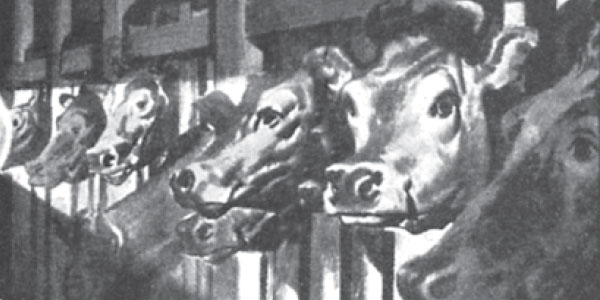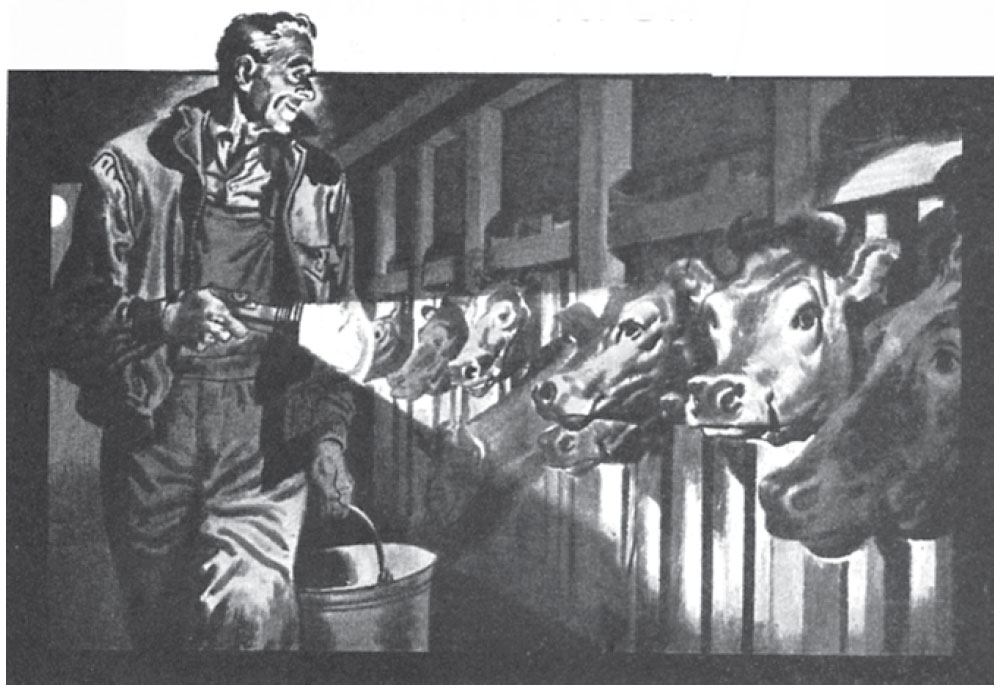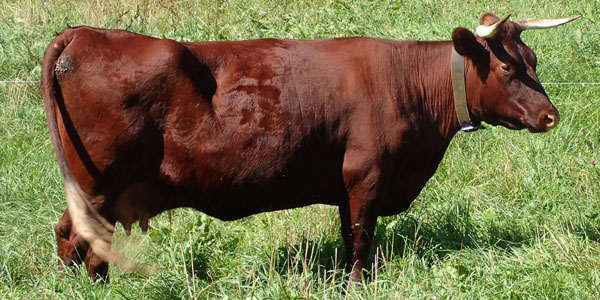
Drumming

Drumming
by Lynn R. Miller of Singing Horse Ranch
The answer is; “men, women and children on their own piece of dirt, building sweet fertility while raising animals and crops to feed people.”
The question is; “what on earth can we do to save the planet and humanity from extinction?”
There are many who can’t accept such a simplistic notion, including some from our own readership. Some don’t believe that people and the earth are in jeopardy. Many who do believe we are at risk cannot see beyond their chosen cause or focus; be it greenhouse gases, environmental pollution, animal rights, food safety, farmland preservation, religious interpretation, endangered species, hunger, war, pestilence, disease, corporate malfeasance, or moral degradation. In each and every case the fight has often been to treat the symptoms not the cause (an approach which has given us a failed health care system). This seriously aggravates the problems. For example, biodiesel will not save us from global warming; it will hasten it as it speeds the poisoning and depletion of our soil resources. A centralized data base maintaining the whereabouts of every small farmer’s poultry and goats (with colored asterisks for location of feedlots and pig factories) will not protect the food supply from pandemic disease, bacterial infestation, or terrorist infiltration. It, instead, will increase the likelihood of these problems by providing dangerous exemptions for industrial producers and creating a readily available computerized roadmap of our food system frailties. Setting farmlands aside in park-like mode does not preserve them as farmlands. Instead it adds to the net loss. And yelling and screaming that the fighting must stop while refusing to see that our economy thrives on the war profits is like facing a household fan into a high wind.
“Enough! Nobody wants to hear such things.There is just so much of this doomsday rhetoric that we can stand. If you have something constructive to say, say it in a pleasing way with pretty pictures; make it diversionary, give us a reason, if only for a moment, to believe you.”
SOMETHING CONSTRUCTIVE TO SAY?
Many of the best small farm examples we discover through SFJ we are unable to share because the people insist that their failures, successes and secrets not be publicized. We must honor that. And in that vein, below I take liberties melding the disguised elements of three very real farm families into one fictitious narrative, which I hope has some demonstrative merit.
On Dan’s farm, just thirty acres, the decision was made to change out the greenhouse heaters from propane to wood fire. He worried just a little that maybe the wood smoke might be a pollutant until he remembered, from years of experience, that the design of the wood stove, as well as the nature of the cordwood, all had dramatic effect on the smoke outlay. He had the excellent firewood held in a common woodlot with his cousins. The propane, on the other hand, had to be bought and delivered.
Besides, the new plantation system in the greenhouses, with heated water ways and layered composting manures collecting and creating warmth under the secondary tenting of plastic, was requiring far less auxiliary heat. Ever since he had read about the Coleman’s portable greenhouses and employed some of the plan to his own flower and vegetable production, it had become second nature for him to see how new ideas might relate. He had come up with his own homemade facility and system for dragging the greenhouses along an extended bedway and incorporating a netted framework for the poultry. Two greenhouse structures and one poultry structure, each thirty foot by sixty foot, were placed all in line on three hundred feet of bedway so that every other season the poultry were contained on a former plantation bed to eat all the insects and larvae and fertilize. Worked slick. It took three years, some mistakes, and a chunk of change but it was all worth it. He marveled at how the soil kept improving and wondered if there was any end to that incline.
Whenever and wherever, Dan did his own cobbled-together constructions. For him, the bigger part of success was in controlling expense. One of his proudest achievements had been the portable waterheater for the greenhouses. On a heavy-duty, steel-wheeled running gear, he had built a metal platform with hinge halves all around the edges. He set an old waterheater tank in the center of the platform. The tank had pipes running in and out but no obvious power or heat source. Then he affixed old oiled, cement-form plywood to the hinges to form a box around the base and tank. He parked the apparatus near the greenhouse and filled the box around the tank with fresh manure from his stabled workhorses. As the manure heated up, it warmed the tank and water which Dan used in cold weather to fill heat transfer ditches in the greenhouse. When the manure was composted and no longer generating heat, he dropped the plywood sides and pulled out the compost for the greenhouse, moving the machine to its next location, folding the box back up, and loading with fresh manure.
Dan’s wife, Mary, was happy to let her husband be the mechanic/inventor of the farm family. Better this than the family history of distilling corn liquor. Herself, she preferred the marketing, all the way from harvesting and packaging produce, eggs, meats, and flowers to the three different farmer’s markets she attended each week throughout the season. She worked as a credentialed substitute school teacher. Even so, in the winter time she always found herself itching to get back to the market stands and her hundreds of devoted customers and friends. There was a conviviality and exchange that filled her up so much that she secretly knew she would have to do this even if they didn’t make money at it. But they did. They made a steady and ever growing stream of money. Plus, recently it had been a wonderful enterprise to share with her growing daughter.
With Chip grown and gone on to his teaching career, Dan and Mary had wondered if they could keep up with all the work but so far, Calley, their daughter, had picked up the slack in most ingenious ways. Like when she had convinced her dad to let Bingo, her trail horse, learn to pull a small one horse spreader through the greenhouses to spread compost and amendments. It was far handier than the Brabant team of draft horses. Plus it had made little Bingo into a much better horse all round. Once the gelding had learned to accept the squealing aromatic piglets on the one end of chores, all the way through to calmly walking into the sometimes-slapping plastic hoop house, any other threatening experience seemed like child’s play to him. And Calley gained confidence along with her horse. Yep, Calley had become a real mainstay. Only thing she couldn’t get into just yet was the chicken butchering. Loved the chickens, even named many of them. Hated the butchering, but she understood its place in the scheme of things.
Dan figured they had about an acre either in greenhouses or affected by them. And then there was another four acres of intensive open air market garden. Tomatoes had been their top money maker for a long while, but specialty herbs and cut flowers were, to his surprise, gaining fast. His twenty acres of remaining arable land had been divided into five four-acre fields which he religiously rotated with occasional crop variants. From pumpkins to watermelons to buckwheat and field peas, he loved the challenges and the variety. He wasn’t sure if he was doing the right thing by pasture and hay crops, as he harvested something from every field each year. His son, the ag teacher was telling him he should think about keeping some of his land in a true permanent pasture. The way things were, he usually had three fields in legume/grass mix, alternatively, for a three to four year run until he plowed it up and planted grain and then a specialty legume, squash, or melon patch before returning to the legume/grass hay and pasture mix. This had worked extremely well for them. Employing the lanes and four acre woodlot on occasion as horse, pig and cattle pasture, he had been able to take a hay cutting off the fields before using them, subdivided by electric fence, for rotated stock pasture. And there had usually been some feed value to the other rotated crops as well. He usually put up about twenty five tons of hay each year which took very good care of the winter feed for three horses, plus one milk cow and six beef cows and their calves. Four acres of grain production went a long ways towards helping keep the poultry flock which, with the pigs, enjoyed many advantages from the garden surplus. Their dozen bee hives were a bonus all the way around. Nothing went for loss.
Dan had enjoyed converting a small old Allis Chalmers motorized combine grain harvester into a fairly modern stationery thresher. He had cut the conveyor bed off an old ensilage blower and attached it on an incline to the throat of the combine, allowing him to throw bindered bundles into the machine for threshing. He did this so that he could continue to run his favorite implement, the old McCormick five foot grain binder. His other implements, mostly horsedrawn, ran the range from new to old, each and every one debt free.
They weren’t eligible for any kind of production credit lending which was fine by them because they didn’t need it. Mortgage on the land was all paid up. Property taxes were all they had to pay that way. In fact the only monthly contract payment they had was on the van Mary used to go to market.
In the beginning, twenty years back, they had gone against conventional wisdom and purchased their small farm a considerable distance from any metropolitan areas. The price had been right. Though a tough go at the start, once they had established themselves as organic farmers and developed markets in the neighboring small towns, income improved by degrees.
A difficult decision had come up a few years back when the federal organic certification kicked in and the fees kept going up. It was Mary who had said, “We don’t need it, our customers know us and our ways.” So they had dropped their ‘certified organic’ distinction. They just put on their labeling, ‘no poisons used, ever.’
In the winter, when time allowed, the family worked together on what had started as Dan’s passion, wooden toys. He loved to invent shapes and movements for toys starting with a block of wood and a carving knife. What had began as a diversion, a hobby, had slowly morphed into a family project with everyone taking some part. Hard to say when it started, but someone had passed on the information that the Curlew family made these incredible toys which they just lined up on a high running shelf around their dining room walls. Before long people were purchasing the toys and ordering more. It became apparent that Dan and family could be doing this full-time if they wished. As these thoughts passed through their heads a representative of a toy company found them and offered substantial money for the toys, the designs, and Dan’s time. When Dan responded, “when would I have time to farm?” the representative laughed and said “Don’t you get it man? This is your ticket off the farm?” Dan just shook his head and said no thank you.
These days they still make toys, only difference is that they now enjoy researching about needy kids in their area and leaving the toys (and some farm raised food) wrapped and setting on unsuspecting doorsteps during the holidays. Calley has taken to keeping a photo album of pictures of each and every toy and sometimes they sit together on a winter evening and thumb through the pictures with tears in their eyes. Dan says, “not ashamed to say it makes me feel good, almost as good as this here farm does.”
On a recent home visit, their son Chip was taking stock of his life. Dan and Mary had done well enough with their small farm that they had been able to contribute to Chip’s college education. Now, after two years of teaching, he was wondering about the true value of his cow college learning and feeling a strong pull to return to the real farming life he had experienced growing up. Plus, there was a young woman in his life and they were talking of marriage and a family. Calley was listening very closely to all of this. Sixteen years-old and thinking about her own future she was more than a little worried about telling her folks that college wasn’t for her. She wanted to study photography, train horses, and have a farm of her own some day. She kept it to herself, but her feeling was that college was a nasty place of questionable value to her in her pursuits and interests.
A short while after Chip’s visit, Dan learned that a neighboring forty acres of neglected farmland was to come up for sale. It was only three quarters of a mile down the road from their place. Late one evening Dan and Mary were talking in the kitchen. They thought Calley was asleep.
“I know honey, but that money we had set aside for Calley’s education.”
“Well, maybe by the time she’s ready, in a couple of years, we could make it up?” offered Dan.
“Don’t count on that.”
“I’m not saying we give it to him. I say we loan it to him. We could even set it up so that he makes the payments directly to Calley.”
She looked at her husband intensely. He looked down at his hands.
“You want him to have what you have, don’t you?”
“Is there anything wrong with that? I want them both to have what we have, but only if that’s what they want.”
She laughed.
“I can see it now. I’ll be competing at the markets with my own children.”
“You always say you’ve got more customers for our stuff than we want to grow for.”
“That’s for sure. But I think we owe it to Calley to get her in on this conversation. I’m not against the idea. I just want to be fair.”
Calley walked into the conversation she’d been overhearing.
“I think it’s a great idea. I’m all for it.” Then she spoke of her own dreams and reservations.
Dan watched his daughter as she spoke and he thanked his lucky stars for the farm that had given him and given him and given him. And just as that idea of a portable greenhouse had given him a way of seeing possible connections, this moment with his family had allowed him to dream about new layers of fertility and continuity. He smiled thinking about helping his daughter and son with their dreams and how they in turn would help their own future children. And he knew he was a most fortunate man.
FROSTING IN THE FORMULA
Their farm was small by most standards, but it was large enough for them. And, just as important, it was large enough for us, all of us. Instead of an ever dwindling and weakening landscape of a few thousand monolithic corporate farms, we are better served by millions of small, diverse, independent fertile family farms. And the more farms we have, the greater the opportunity of success for each. The landscape would heal, the countryside would welcome the return of vibrant small farm communities, the economy would strengthen, our capacity to feed people would increase in quantity and health, the immune systems of an ever growing number of people would improve, the governments would move offshore, the moral base would once again rise up from the truths of actual working, and the ranks of the hungry would shrink day by day.
I scratch my head and I think and wonder but I cannot come up with any social model to compete with the small farm. It is our hope. So we must keep saying it, working towards it, embracing it, keeping it alive. The small farm is the answer.
It is the steady drip which eventually drills through the rock. We need to maintain the steady drip. We must never give up working to drill through that rock. In our case, for the true farmer, the drip is more like an incessant drum beat; small, soft and in the background. And the rock is harder to describe or define: it may be the mistaken social notion of what constitutes correct order.
I suspect most people have no collective notion of what constitutes correct order these days. Religions cannot agree. Judges cannot agree. Government cannot govern. The marketplace has become the handmaiden of a corporate communism. And they search for a new pill or gizmo to get us through the day.
But those in the fields, barns, sheds, woods, they know there is a correct order. They know that independent human-scaled enterprise, most specifically the family farms, when gathered together side by side offer the best, lasting, fertile, regenerative hope for the planet and for humankind.




